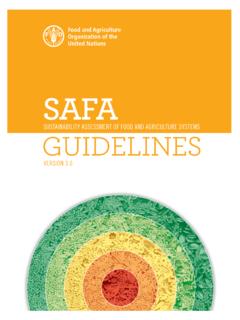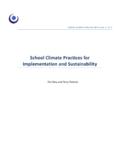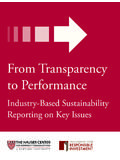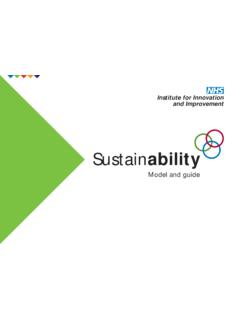Transcription of A Perspective on environmental sustainability
1 A Perspective on environmental sustainability ? A paper for the Victorian Commissioner for environmental sustainability This paper was written by Philip Sutton Director-Strategy of Green Innovations Version 12-April-2004. i Introduction and Overview environmental sustainability and what it means for us all environmental sustainability is the ability to maintain the qualities that are valued in the physical environment. For example, most people want to sustain (maintain): human life the capabilities that the natural environment has to maintain the living conditions for people and other species (eg. clean water and air, a suitable climate). the aspects of the environment that produce renewable resources such as water, timber, fish, solar energy the functioning of society, despite non-renewable resource depletion the quality of life for all people, the livability and beauty of the environment Threats to these aspects of the environment mean that there is a risk that these things will not be maintained.
2 For example, the large-scale extraction of non-renewable resources (such as minerals, coal and oil) or damage done to the natural environment can create threats of serious decline in quality or destruction or extinction. Traditionally, when environmental problems arise environmental managers work out how to reduce the damage or wastage. But it is not always easy to work out exactly when and where threats will have their effects and often the impacts are hard to reverse. So increasingly environmental managers adopt strategies aimed to prevent damage being done in the first place. A full sustainability program needs to include actions to prevent threats and impacts from arising, actions to protect the environment from threats and damage, and restoration to reverse damage already done.
3 sustainability issues arise wherever there is a risk of difficult or irreversible loss of the things or qualities of the environment that people value. And whenever there are such risks there is a degree of urgency to take action. environmental sustainability programs include actions to reduce the use of physical resources, the adoption of a recycle everything/buy recycled' approach, the use of renewable rather than depletable resources, the redesign of production processes and products to eliminate the production of toxic materials, and the protection and restoration of natural habitats and environments valued for their livability or beauty. These sustainability programs need to operate on an adequate scale and need to continue operating reliably for as long as the threats continue.
4 Some of the issues that pose major environmental sustainability problems include: destruction of the living environments (habitats) of native species discharge of polluting chemicals and other materials into the environment emission of greenhouses gases into the atmosphere than can cause climate change depletion of low cost oil and other fossil fuels ii Some environmental issues are largely of local significance while others have regional or even global relevance. At the personal or household level, there are a host of actions that people can take to contribute to environmental sustainability at home, when travelling or accessing services or goods, at work, or when acting as a community member or citizen or as an investor of personal funds. Some useful examples are include living close to work where possible and walking, using a bike or using public transport.
5 These are good options to save energy and reduce greenhouse gases. If these options are not possible then using an ultra- efficient hybrid petrol/electric vehicle can cut greenhouse gases and petrol consumption by about 50% and cut other toxic pollutants by about 90%. Buying products made of recycled materials will generally save materials and energy, cut greenhouse gases and toxic pollution, and reduce impacts on living things in the wild. Installing a water tank and low flow shower can save water. Building or renovating a house using environmental sound design and lower impact materials and 5+ star appliances can make a big impact on all environmental issues. Using food in season or from local sources and organically grown can cut impacts from chemicals, save energy and reduce greenhouse gases.
6 Involvement in or donations to community environmental groups can help with practical projects like revegetation or by building support for effective government policies. And investing savings in ethical investments can help accelerate the creation of an environmentally-sustainable economy. iii Table of contents Introduction and environmental sustainability and what it means for us all ..i Preamble ..1. A preferred definition of environmental What is the physical environment? ..1. What makes an issue a sustainability issue? ..2. What exactly are we trying to maintain in the physical environment and who decides?..2. What motivates us to want to sustain something in the physical environment?..2. How long should we try to sustain something? ..3. Is there any connection between environmental sustainability and social or economic sustainability ?
7 3. Can the idea of environmental sustainability drive commitments to specific action? ..4. Is restoration part of an environmental sustainability program? ..4. If we pursue an environmental sustainability program how much should we try to sustain?..4. The origin of the core word 'sustain' and its main The drifts in meaning ..5. The benefits of definitional clarity and a strong relationship to core Developing a preferred definition of environmental sustainability ..8. A compatible suite of sustainability The problematic usage of sustainability -related terms ..14. Translating the usage of sustainability -related Related concepts and definitions ..16. Ecologically sustainable development ..16. The Triple Bottom Integrating sustainability , Genuine progress, Triple Bottom How to use the definition of environmental sustainability to facilitate effective action.
8 21. A - What preferred state (condition) do we want/need to achieve?..22. B - What state are we in now? ..25. C - How do we get to our preferred future from here, with the least loss along the way? ..25. D - What should we do right now? ..26. 1. Preamble In 2003, the Parliament of Victoria established the role of Commissioner for environmental Sustainability1 (1). The Commissioner acts as an independent voice that advocates, audits and reports on environmental sustainability . The purpose of this paper is to explore the meaning of environmental sustainability . The community needs a definition of environmental sustainability that is easily understood, is logical, and is helpful in facilitating understanding, communication and effective action by all key players (government, community, business, innovators, academia, communicators, etc.)
9 The paper also explores the meaning of related terms and definitions eg. ' sustainability ' and related words in common usage 'ecologically sustainable development' (as defined by the Commissioner's enabling legislation). 'sustainable development' (the Brundtland definition). 'triple bottom line'. A preferred definition of environmental sustainability environmental sustainability is "the ability to maintain things or qualities that are valued in the physical environment "2. This is the simplest and most fundamental way to express the concept. But people using the term environmental sustainability can specify or elaborate the term further to add extra meaning or to apply the concept to more specialised contexts. What is the physical environment? This is the physical surrounds to something.
10 For example, the land, waters and atmosphere, physical resources and the buildings and roads and other physical elements go to make up the urban environment. Rural environments are made up of the farms and living areas of people and the land and waters and atmosphere and biological elements (species utilised by agriculture, pest species, and native species, and ecological communities both human induced and natural). Natural environments are those where the influence of wild species (indigenous and naturalised) is dominant or very strong. Physical resources, of all sorts, including mineral resources, can be considered to be part of the environment. Physical environments can be considered on all scales from the micro to the local, global and even larger scales.







